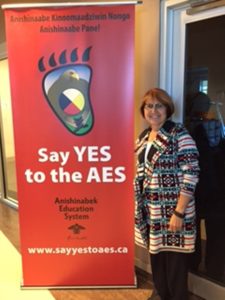‘We get to determine what programs get to be funded’ says Aamjiwnaang Chief on the AES
By Rick Garrick

AAMJIWNAANG FIRST NATION—Aamjiwnaang Chief Joanne Rogers says control over education resources is a key reason for signing on with the Anishinabek Nation Education Agreement.
“We get to determine what programs get to be funded,” Rogers says. “We are going to have more Aboriginal programs. And [our students] are going to better understand our ancestors and know who they are, get back to the traditional teachings, learn about the Seven Grandfather teachings. They’re going to be able to get more of that and understand it.”
Rogers says the community currently has a Junior Kindergarten program and plans to implement a senior kindergarten program by 2017-18. All other students are bused to elementary and secondary schools outside of the community.
“We have a good relationship [with the school board], but it most certainly will improve,” Rogers says. “We will have, I believe, more say in what books our children read and what we want to see more of. We want more of the Native program, more programs as it relates to our history, especially in the local areas. That is what I would like to see: our history taught to our children, and we’ll have a lot bigger say in that.”
Rogers says the public schools have already developed a variety of Native education initiatives, including Native education workers, rooms for Indigenous students to gather, and Native artwork displays.
“They’re teaching the other students in the school how to make dreamcatchers,” Rogers says. “That’s a good thing — it’s something I never had when I went to high school. But it’s in our schools now and we’ll be able to decide how to spend that [education] money on getting more of that cultural material [in the schools].”
Grand Council Chief Patrick Madahbee encourages all communities to learn more about the Say Yes to AES campaign in order to make an informed decision on how to vote. He also encourages all community members to get out and vote during the Ratification Vote week, which takes place from Nov. 28 to Dec. 2.
“This means more per-student funding,” Madahbee says. “This is for our children.”
The Anishinabek Nation has been running a Say Yes to AES campaign since November 2015.
Information about the proposed agreement with Canada, fiscal arrangements, and the Anishinabek Education System can be found on the Say Yes to the AES website.
The benefits of ratifying the Education Agreement for communities without schools include secure, predictable funding to deliver education programs and services and purchase services from provincial school boards, the development of a new relationship with provincial school boards to enhance student success and well-being, and the opportunity to develop and implement curriculum changes in the provincial education system. Additional benefits are listed on the Say Yes to AES website.
The benefits of ratifying the Education Agreement for communities with schools include having full control over all aspects of education from JK to Grade 12, the opportunity to develop and implement Anishinabek curriculum and education standards, and have shared resources to support student success. Other benefits are also listed on the Say Yes to AES website.

